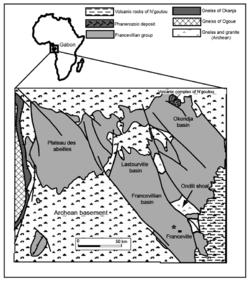Earth:Francevillian B Formation
| Francevillian B Formation Stratigraphic range: Palaeoproterozoic (Rhyacian) 2140–2080 Ma | |
|---|---|
| Type | Geological formation |
| Unit of | Francevillian Basin |
| Area | 25,000 square kilometers (9,700 sq mi) |
| Lithology | |
| Primary | Black Shale |
| Location | |
| Region | East-central Gabon |
| Country | |
| Extent | 35,000 kilometers (22,000 mi) |
| Type section | |
| Named for | Franceville, a nearby town |
| Named by | Abderrazak El Albani |
 Map of the Geology of the Franceville basin | |
The Francevillian B Formation, also known as the Francevillian Formation or FB2 in scientific research, is a geologic formation of black shale provinces close to the town of Franceville, Gabon from where it gets its name from. The formation was deposited between 2.14-2.08 Ga (billion years ago) in the Palaeoproterozoic,[1] and, uniquely, has not experienced any thermal overprinting due to diagenesis after burial nor significant metamorphism since it was deposited, unlike other formations deposited around the same time.[2] The formation contains possible fossils, including the macroscopic "Francevillian Biota", which has been suggested by some authors to represent the oldest known multicellular organisms,[3][4] though other authors have questioned the supposed biological origin of the structures, and have suggested that they may instead be inorganic, such as artifacts of diagenesis.[5][6]
Geology
The Francevillian Formation has recently been discovered to contain traces of uranium. The Francevillian basin itself already contained Oklo Mine, a natural nuclear reactor.[7][8][9][10] However, the formation also witnessed a former system of petroleum which showed major amounts of uranium associated with organic matter. Several episodes of oil generation, migration and fluid mixing along with hydrofracturing are the cause of the uranium mineralization.[10] During burial of the formation, its multiple black shales were heated and in doing so expelled hydrocarbons that migrated into underlying sandstones, with the first episode of the oil migration being synchronous along with a silicification event that derived into a hot and low salinity fluid which is proven by fluid inclusions trapped in overgrowths of quartz.[10] However, the second episode of the oil migration was contemporaneous and has quartz dissolution with the episode being characterized by the mixing of hydrocarbons and oxidizing the uranium-bearing brine which in turn caused the precipitation of UO2 to be included in the oils. In the third and final episode of oil migration within the Francevillian B formation, oil-to-gas conversion generated overly-pressured gas trapped with uraniferous bitumen nodules in pores. Changes in the stress regime probably favoured radial hydrofracturing around the bitumen nodules as well as the subsequent development of a somewhat pervasive micro-fracture network.[10]
Possible fossils
The formation has been proposed to have preserved microfossils,[11] as well as flattened disk-like macrofossils, the latter dubbed the "Francevillian biota". The initial discovers have claimed that the large structures claimed to be fossils are the oldest known multicellular organisms and eukaryotes,[3][4] while other authors are more skeptical, suggesting that they may be of inorganic origin, such as an artifact of diagenesis.[5][6]
See also
- Francevillian Biota
- Franceville basin
- Burgess Shale
- Oklo Mine
References
- ↑ Lekele Baghekema, Stellina G.; Lepot, Kevin; Riboulleau, Armelle; Fadel, Alexandre; Trentesaux, Alain; El Albani, Abderrazak (2017). "Nanoscale analysis of preservation of ca. 2.1 Ga old Francevillian microfossils, Gabon". Precambrian Research 301: 1–18. doi:10.1016/j.precamres.2017.08.024. Bibcode: 2017PreR..301....1L. https://www.sciencedirect.com/science/article/abs/pii/S0301926817302437.
- ↑ El Albani, Abderrazak; Bengtson, Stefan; Canfield, Donald E.; Riboulleau, Armelle; Rollion Bard, Claire; MacChiarelli, Roberto; Ngombi Pemba, Lauriss; Hammarlund, Emma et al. (2014). "The 2.1 Ga Old Francevillian Biota: Biogenicity, Taphonomy and Biodiversity". PLOS ONE 9 (6): e99438. doi:10.1371/journal.pone.0099438. PMID 24963687. Bibcode: 2014PLoSO...999438E.
- ↑ 3.0 3.1 El Albani, Abderrazak et al. (2010). "Large colonial organisms with coordinated growth in oxygenated environments 2.1 Gyr ago". Nature 466 (7302): 100–104. doi:10.1038/nature09166. PMID 20596019. Bibcode: 2010Natur.466..100A. http://www.afrikibouge.com/publications/Article%20Albani.pdf.[yes|permanent dead link|dead link}}]
- ↑ 4.0 4.1 El Albani, Abderrazak (2023). "A search for life in Palaeoproterozoic marine sediments using Zn isotopes and geochemistry". Earth and Planetary Science Letters 623: 118169. doi:10.1016/j.epsl.2023.118169. Bibcode: 2023E&PSL.61218169E. https://www.sciencedirect.com/science/article/pii/S0012821X23001826.
- ↑ 5.0 5.1 Javaux, Emmanuelle J.; Lepot, Kevin (January 2018). "The Paleoproterozoic fossil record: Implications for the evolution of the biosphere during Earth's middle-age" (in en). Earth-Science Reviews 176: 68–86. doi:10.1016/j.earscirev.2017.10.001. Bibcode: 2018ESRv..176...68J. https://linkinghub.elsevier.com/retrieve/pii/S0012825217304890. ""The identity of the [Francevillian biota] macrostructures remains unknown and their biogenicity is questionable"".
- ↑ 6.0 6.1 Fakhraee, Mojtaba; Tarhan, Lidya G.; Reinhard, Christopher T.; Crowe, Sean A.; Lyons, Timothy W.; Planavsky, Noah J. (May 2023). "Earth's surface oxygenation and the rise of eukaryotic life: Relationships to the Lomagundi positive carbon isotope excursion revisited" (in en). Earth-Science Reviews 240: 104398. doi:10.1016/j.earscirev.2023.104398. Bibcode: 2023ESRv..24004398F. https://linkinghub.elsevier.com/retrieve/pii/S0012825223000879.
- ↑ Meshik, A. P. (November 2005). "The Workings of an Ancient Nuclear Reactor". Scientific American 293 (5): 82–6, 88, 90–1. doi:10.1038/scientificamerican1105-82. PMID 16318030. Bibcode: 2005SciAm.293e..82M. http://www.sciam.com/article.cfm?id=ancient-nuclear-reactor.
- ↑ Mervine, Evelyn (July 13, 2011). "Nature's Nuclear Reactors: The 2-Billion-Year-Old Natural Fission Reactors in Gabon, Western Africa". blogs.scientificamerican.com. https://blogs.scientificamerican.com/guest-blog/natures-nuclear-reactors-the-2-billion-year-old-natural-fission-reactors-in-gabon-western-africa/.
- ↑ Gauthier-Lafaye, F.; Holliger, P.; Blanc, P.-L. (1996). "Natural fission reactors in the Franceville Basin, Gabon: a review of the conditions and results of a "critical event" in a geologic system". Geochimica et Cosmochimica Acta 60 (25): 4831–4852. doi:10.1016/S0016-7037(96)00245-1. Bibcode: 1996GeCoA..60.4831G.
- ↑ 10.0 10.1 10.2 10.3 Lecomte, Andreï; Michels, Raymond; Cathelineau, Michel; Morlot, Christophe; Brouand, Marc; Flotté, Nicolas (2020). "Uranium deposits of Franceville basin (Gabon): Role of organic matter and oil cracking on uranium mineralization". Ore Geology Reviews 123: 103579. doi:10.1016/j.oregeorev.2020.103579. Bibcode: 2020OGRv..12303579L.
- ↑ Lekele Baghekema, Stellina G.; Lepot, Kevin; Riboulleau, Armelle; Fadel, Alexandre; Trentesaux, Alain; El Albani, Abderrazak (October 2017). "Nanoscale analysis of preservation of ca. 2.1 Ga old Francevillian microfossils, Gabon" (in en). Precambrian Research 301: 1–18. doi:10.1016/j.precamres.2017.08.024. Bibcode: 2017PreR..301....1L. https://linkinghub.elsevier.com/retrieve/pii/S0301926817302437.
External links
- For more images of the Francevillian biota, see Experiment Life – the Gabonionta (English version).
 |

